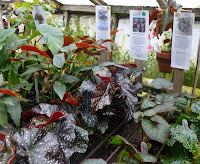Because it is Christmas Eve and I do not believe in
frightening people unnecessarily, I will tell the end of this harrowing story
first, then go back to the beginning.
And so, here goes: I am happy to
report that I am alive to write this, and my oldest friend, Hank Rawlings, is not going to get a
set of bongo drums for Christmas.
Now, to the beginning of the story.
 |
| Hank and me, circa 2007 |
 |
| A spindly oak, probably this one, leaned precariously into our garden. That's Danielson Pond at the property edge. |
To be completely honest, Betty has had the tree removal on my
‘to-do’ list ever since we had to shake a coating of snow and ice off of it to
get it off our deck last January, but I have successfully put off the task by
various subterfuges, the most persuasive was that the oak could not just be cut
down with a chain saw. It is less than
thirty feet from the back of our house and, based on the direction it was
leaning, it would take out our back deck and a portion of our Great Room, a Cornus mas (Cornelian cherry), and a
very rare Chamaecyparis pisifera
‘Snow’ – not necessarily in that order of importance to Betty.
The tree, I argued, needed to be cut half-way up so that its
top half fell harmlessly into some minor shrubs and pathways. To get twenty feet up the trunk of the tree
required a suitable, sturdy ladder and the tall wooden one we possessed was more
than half a century old and was – literally and figuratively – falling
apart.
 |
| The 22-foot Little Giant |
And so, yesterday morning, with all excuses gone, I unfolded
the ladder to its maximum height and set out to finally perform the feat that I
had promised to do all year. I secured a
rope around the tree above the cut line and Betty positioned herself off to one
side, ready to guide the falling tree into one of minimal landscape damage.
I made a practice cut, taking off a largish side branch
roughly fifteen feet off the ground.
When the limb fell, the tree bucked and I had to hold on for dear
life. If that was the effect a smaller branch had, it was likely that the Main
Event would slingshot me and the ladder into, at minimum, the adjoining trees, and possibly all the way to Danielson Pond.
Betty suggested tying the ladder to the tree. I thought this was a good idea. She also suggested lashing myself to the tree. I did not like this idea one bit. I imagined the top of the tree snapping over,
the base of the tree bucking violently, the ladder flying free, and me hanging
from the trunk of the tree in a vignette out of the song, ‘Tom Dooley’.
 |
| Hank and me in the 6th grade. Educators will note with horror there is one teacher and 31 kids. |
I went back up, and gave the trunk a few more cuts, all the
time listening for that tell-tale cracking sound. And, I readily confess, I began to worry for
my safety. Here I was, at the top of a
very tall ladder, sawing above my head, with sawdust falling into my face.
I began to think about… Christmas presents.
I am told that I am very hard to buy presents for. That is quite true for the simple reason that
I have long had all of the ‘things’ I ever wanted. When Betty asked what I wanted this year, all
I could come up with was the very practical suggestion that my bedroom slippers
are worn out. I was subsequently given a
number of ultimatums to come up with better ideas.
 |
| "Desk Set" - for the man who has everything... bongo drums |
So the question was, if the next cut was the crucial one and
I did not get out of the way of the tree quickly enough, and the tree bucked me
and the ladder onto one of the many large, granite boulders that grace our woods, to whom
could Betty give the bongo drums? I
decided my oldest friend, Hank Rawlings, was the right recipient. My fear was that, with my dying breath, she
might not understand this part of my last will and testament.
Maybe I was thinking too hard about bongo drums. I gave the tree an insignificant but crucial
cut and heard just a single warning ‘snap’.
The top twenty-three feet of the tree fell over. Later, Betty would say she heard ‘snap-snap-craaaaaack’
before it fell.
 |
| Chamaecyparis ‘Snow’ was undamaged by felling the tree |
I hung onto the ladder with a grip I did not know I
possessed and the tree’s kick was strong enough to slam the ladder into my
thigh.
But a second later, I was still on the ladder, fifteen feet
above ground, shaken but very much alive.
The tree’s top was on the ground, having missed the house and deck by
roughly five feet; completely missing the Cornus,
and inflicting very minor damage on Chamaecyparis
‘Snow’.
Seeing that I was shaken, Betty asked if I was all
right. I responded that I was fine but
that I hoped she had not bought me bongo drums for Christmas. She looked at me quizzically, then smiled.









